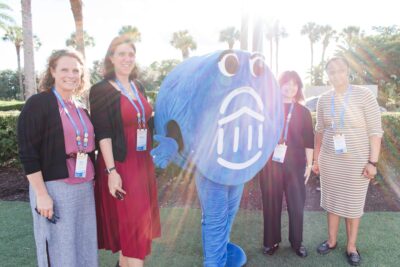4 strategies to bridge the skills gap between community college and career
While a large majority of employers today look for candidates who have postsecondary education, the jump from college to career can still be confusing, daunting, and challenging for students—and community college students are no exception.
That’s not because these students aren’t career-oriented; in fact, quite the opposite. They’re highly likely to already be thinking about their careers by the time they’re enrolled. According to the Community College Survey of Students Engagement (CCSSE), nine out of 10 students say that they’ve already chosen a career path.
These students are often juggling a wide variety of commitments and responsibilities—from work and family to commuting—that limit the time they can spend working toward their careers. There’s an opportunity for colleges to offer the vital information, skills, and opportunities to connect their career aspirations to what they’re learning in the classroom.
What is the skills gap between community colleges and career?
The skills gap between community colleges and career is the mismatch between community college students’ skills and the ones that employers are looking for. It’s not that they don’t have valuable skills, but rather that they don’t know the ones they’ll need in the workplace. According to CCSSE, over half of students in community colleges say they only know somewhat, very little, or nothing at all about the skills they need for their chosen career path.
Again, the issue is not that these students aren’t career-minded—in fact, they’re thinking clearly about their careers already—but rather they need help to connect their classroom experience to employability. They don’t know what skills they need to succeed in the workplace or what in-demand job opportunities are available to them.
We know that community colleges can be an incredible gateway to future career success. Because these institutions are more accessible and come at a lower cost, students in historically underserved and underrepresented populations can get the education they need to become more employable—whether that’s by getting a degree or technical credential or completing credits they can transfer into higher degree programs.
Now, it’s time to help bridge the skills gap between what their students in the classroom and their ability to succeed in the world of work.
4 strategies for closing the skills gap between community colleges and careers
Connecting students with the skills, experience, and knowledge they need to land a job after graduation is crucial for student success and beyond. Here are four strategies for bridging the skills gap between community colleges and careers, including in-classroom initiatives, career services programs, and external partnerships.
1. Focus on building workplace skills in the classroom
Skills are top-of-mind for employers hiring entry-level candidates; 70% of corporate leaders report that they have a critical skills gap in their company. Financial services and technology are industries with the biggest technical skill gaps, with skills like data analysis, project management, AI/machine learning, and software engineering being the most sought after.
Community colleges can foster workforce readiness for their students by focusing on building skills that employers are looking for in the classroom.
Job simulations* are an easy, free way to start helping students not only build in-demand workplace skills, but also understand how they work in the context of a professional environment. Faculty at community colleges can assign job simulations as mandatory assignments to instantly bridge the gap between what students are learning in the classroom and how those skills apply to real-world work scenarios.
2. Partner with local employers looking to hire college graduates
According to CCSSE, 72% of two-year college graduates stayed within the same metro area after completing their degree, compared to less than half of public four-year college graduates. This means that understanding the local job market is crucial to finding employment success for these students—yet only one fifth of community college students say their college helped them learn about their local job market sufficiently.
Partnering with local employers to understand their hiring plans and needs can help give students a better idea of what opportunities are open to them after they graduate. Employers may also be willing to sponsor programs, training days, or other career events to help students learn about their company and open opportunities. College staff may work directly with community workforce boards to understand hiring needs in the local community. Both employers and college faculty may collaborate on how to offer more training for specific in-demand skills, whether as a part of the curriculum on in employer-sponsored campus programs.
It’s a win-win: community colleges learn what local employers are looking for and can train their students, and employers get a candidate pool of students who’ve built the in-demand skills they need.
3. Offer tailored career support and guidance
It’s no secret that community college students—who may face financial instability, hold part-time jobs, or have other competing priorities—need extra support to succeed in school. To fully support these students, we must plan for their post-graduation journey. What comes next, and how can we demonstrate that their college experience is a direct stepping stone to their career?
CCSSE shows that students who used career counseling services not only felt like they knew what skills they needed to pursue their desired career path, but also boosted their knowledge of in-demand jobs and their potential earnings post-college.
Offering comprehensive career services outside of the classroom can be a crucial place for students to learn the basic skills they need to land a job, whether that’s where to look for roles, how to write a resume, or what to wear for an interview. It’s even more important that these career services are accessible and not an added burden for your already busy students. Offering remote sessions, for example, can help make these services more accessible to students who may commute to campus; making career services appointments easy to schedule can decrease friction for a student interested in career help to get the support they need.
4. Focus on work-based experiences
According to CCSE, participation in an internship-type experience (including field experience, co-op experience, or clinical assignment) is one of the best ways to develop the skills they need in their chosen career path. Yet only 19% of the CCSSE respondents reported that they’d participated in an internship-like experience.
Participation in these experiences is likely low because they can be hard to attain, especially if you don’t have industry connections or the time to dedicate the often many, many hours it takes to apply and land one. The opportunities themselves can also be inaccessible: 40% of internships are still unpaid. Many internships have inflexible work schedules that make it harder, or impossible, for students who have commitments like childcare and part-time work to participate. Others may require going into an office that’s difficult to use public transportation to get to, or a professional wardrobe that students may not have in their closet.
*If internship-type experiences are one of the top ways to help community college students feel career-ready, but internships aren’t always accessible to these students, community colleges can step up to provide experiential learning right on campus, right in their own classrooms, with programs like Forage job simulations.
Forage is a free, accessible way to institute work-based learning experiences into the classroom. Forage offers a variety of job simulations from top employers like Ford and KPMG U.S. Job simulations are online, project-based experiences that allow students to see a day-in-the-life in various roles, career paths, and companies.
With each job simulation, students practice in-demand job skills, boost their professional confidence, and build a portfolio of work they can add to their resume and talk about in interviews. Community colleges who leverage Forage already use the platform to help students “connect the dots” between in-classroom learning and the workplace. For example, the Borough of Manhattan Community College uses an accounting Forage job simulation in their “Intro to Accounting” course to help students understand the career applications of what they’re learning in the classroom.
Faculty interested in using Forage to bridge the classroom to careers can sign up here. Questions? Reach out at [email protected].
The bottom line
Career success for community college students lies in active strategies to bridge the gap between what students learn in the classroom and the opportunities they’ll have post-graduation. By connecting the dots between what students are interested in pursuing and in-demand skills and opportunities, these students can thrive not only in the classroom, but beyond.
More Blogs

Four signs it’s time to break up with your student CRM

Three lessons from 1,200 student success leaders on higher ed’s future
